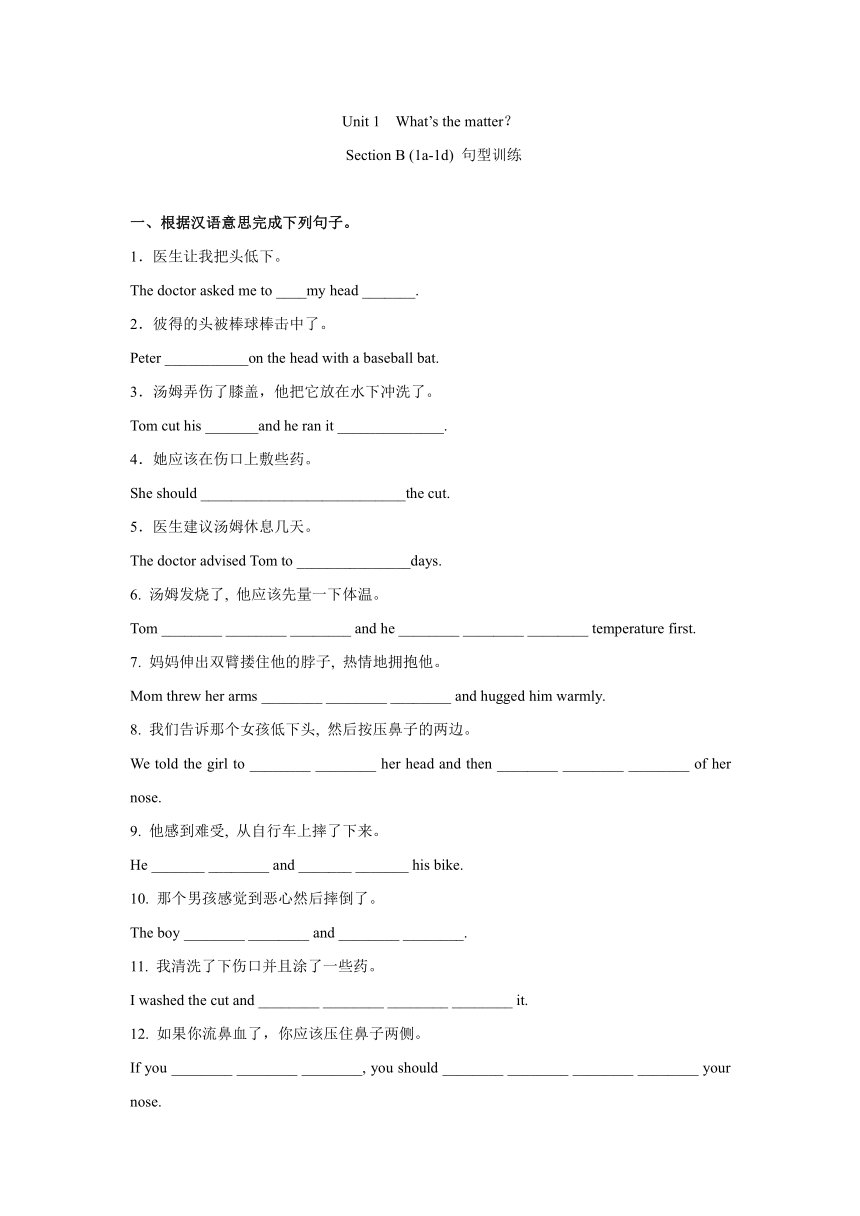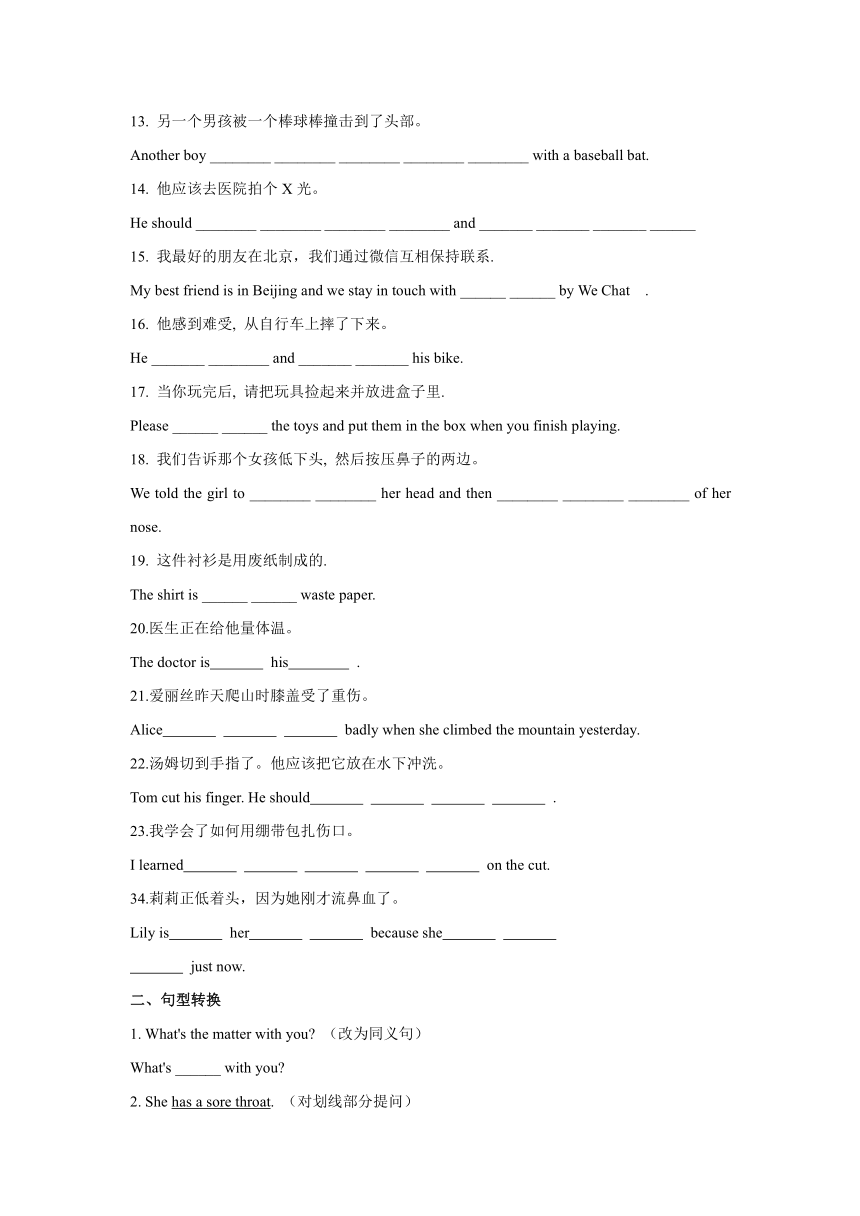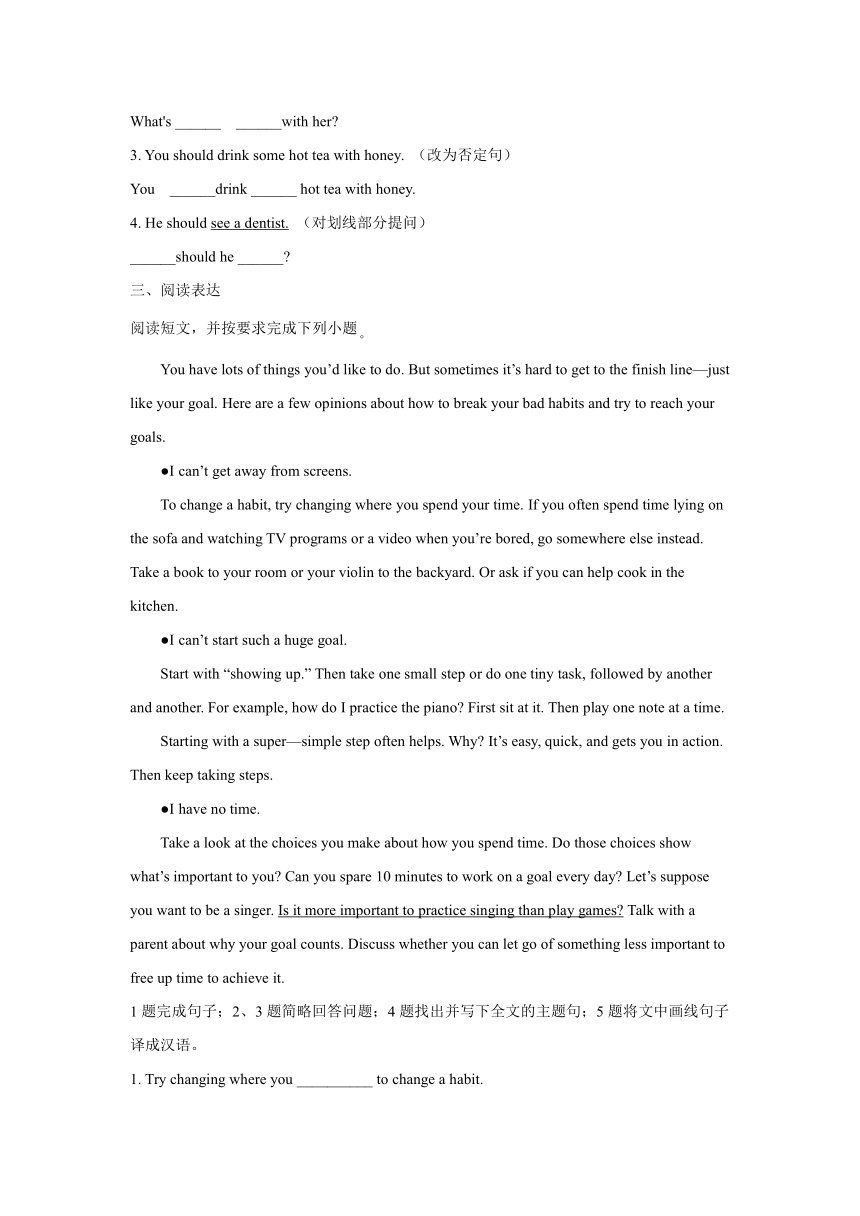Unit 1 What's the matter Section B (1a~1d) 句型练习(含解析)人教版八年级英语下册
文档属性
| 名称 | Unit 1 What's the matter Section B (1a~1d) 句型练习(含解析)人教版八年级英语下册 |  | |
| 格式 | docx | ||
| 文件大小 | 26.4KB | ||
| 资源类型 | 教案 | ||
| 版本资源 | 人教新目标(Go for it)版 | ||
| 科目 | 英语 | ||
| 更新时间 | 2025-02-24 12:05:57 | ||
图片预览



文档简介
Unit 1 What’s the matter?
Section B (1a-1d) 句型训练
一、根据汉语意思完成下列句子。
1.医生让我把头低下。
The doctor asked me to ____my head _______.
2.彼得的头被棒球棒击中了。
Peter ___________on the head with a baseball bat.
3.汤姆弄伤了膝盖,他把它放在水下冲洗了。
Tom cut his _______and he ran it ______________.
4.她应该在伤口上敷些药。
She should ___________________________the cut.
5.医生建议汤姆休息几天。
The doctor advised Tom to _______________days.
6. 汤姆发烧了, 他应该先量一下体温。
Tom ________ ________ ________ and he ________ ________ ________ temperature first.
7. 妈妈伸出双臂搂住他的脖子, 热情地拥抱他。
Mom threw her arms ________ ________ ________ and hugged him warmly.
8. 我们告诉那个女孩低下头, 然后按压鼻子的两边。
We told the girl to ________ ________ her head and then ________ ________ ________ of her nose.
9. 他感到难受, 从自行车上摔了下来。
He _______ ________ and _______ _______ his bike.
10. 那个男孩感觉到恶心然后摔倒了。
The boy ________ ________ and ________ ________.
11. 我清洗了下伤口并且涂了一些药。
I washed the cut and ________ ________ ________ ________ it.
12. 如果你流鼻血了,你应该压住鼻子两侧。
If you ________ ________ ________, you should ________ ________ ________ ________ your nose.
13. 另一个男孩被一个棒球棒撞击到了头部。
Another boy ________ ________ ________ ________ ________ with a baseball bat.
14. 他应该去医院拍个X光。
He should ________ ________ ________ ________ and _______ _______ _______ ______
15. 我最好的朋友在北京,我们通过微信互相保持联系.
My best friend is in Beijing and we stay in touch with ______ ______ by We Chat .
16. 他感到难受, 从自行车上摔了下来。
He _______ ________ and _______ _______ his bike.
17. 当你玩完后, 请把玩具捡起来并放进盒子里.
Please ______ ______ the toys and put them in the box when you finish playing.
18. 我们告诉那个女孩低下头, 然后按压鼻子的两边。
We told the girl to ________ ________ her head and then ________ ________ ________ of her nose.
19. 这件衬衫是用废纸制成的.
The shirt is ______ ______ waste paper.
20.医生正在给他量体温。
The doctor is his .
21.爱丽丝昨天爬山时膝盖受了重伤。
Alice badly when she climbed the mountain yesterday.
22.汤姆切到手指了。他应该把它放在水下冲洗。
Tom cut his finger. He should .
23.我学会了如何用绷带包扎伤口。
I learned on the cut.
34.莉莉正低着头,因为她刚才流鼻血了。
Lily is her because she
just now.
二、句型转换
1. What's the matter with you (改为同义句)
What's ______ with you
2. She has a sore throat. (对划线部分提问)
What's ______ ______with her
3. You should drink some hot tea with honey. (改为否定句)
You ______drink ______ hot tea with honey.
4. He should see a dentist. (对划线部分提问)
______should he ______
三、阅读表达
阅读短文,并按要求完成下列小题
You have lots of things you’d like to do. But sometimes it’s hard to get to the finish line—just like your goal. Here are a few opinions about how to break your bad habits and try to reach your goals.
●I can’t get away from screens.
To change a habit, try changing where you spend your time. If you often spend time lying on the sofa and watching TV programs or a video when you’re bored, go somewhere else instead. Take a book to your room or your violin to the backyard. Or ask if you can help cook in the kitchen.
●I can’t start such a huge goal.
Start with “showing up.” Then take one small step or do one tiny task, followed by another and another. For example, how do I practice the piano First sit at it. Then play one note at a time.
Starting with a super—simple step often helps. Why It’s easy, quick, and gets you in action. Then keep taking steps.
●I have no time.
Take a look at the choices you make about how you spend time. Do those choices show what’s important to you Can you spare 10 minutes to work on a goal every day Let’s suppose you want to be a singer. Is it more important to practice singing than play games Talk with a parent about why your goal counts. Discuss whether you can let go of something less important to free up time to achieve it.
1题完成句子;2、3题简略回答问题;4题找出并写下全文的主题句;5题将文中画线句子译成汉语。
1. Try changing where you __________ to change a habit.
2. Why is it often helpful to start with a super-simple step
____________________________________________
3. How long does the writer ask you to spare to work on a goal every day
____________________________________________
4. ____________________________________________
5. ____________________________________________
一、根据汉语意思完成下列句子。
put; down:“put one's head down” 表示 “低下头”,“ask sb. to do sth.” 要求某人做某事,故填 “put; down”。
got hit:“get hit on the head” 表示 “头部被击中”,事情发生在过去,用一般过去时,故填 “got hit”。
knee; under water:“cut one's knee” 表示 “割伤某人的膝盖”,“run sth. under water” 表示 “把某物放在水下冲洗”,故填 “knee; under water”。
put some medicine on:“put some medicine on...” 表示 “在…… 上敷些药”,“should” 后接动词原形,故填 “put some medicine on”。
take a few days' rest:“advise sb. to do sth.” 表示 “建议某人做某事”,“take a few days' rest” 表示 “休息几天”,故填 “take a few days' rest”。
has a fever; should take his:“have a fever” 表示 “发烧”,主语 “Tom” 是第三人称单数,用 “has”;“should” 后接动词原形,“take one's temperature” 表示 “量某人的体温”,故填 “has a fever; should take his”。
around his neck:“throw one's arms around sb.'s neck” 表示 “伸出双臂搂住某人的脖子”,故填 “around his neck”。
put down; press the sides:“tell sb. to do sth.” 表示 “告诉某人做某事”,“put down one's head” 表示 “低下头”,“press the sides of one's nose” 表示 “按压鼻子两侧”,故填 “put down; press the sides”。
felt sick; fell off:“feel sick” 表示 “感到难受”,“fall off” 表示 “从…… 上摔下来”,事情发生在过去,用一般过去时,故填 “felt sick; fell off”。
felt sick; fell down:“feel sick” 表示 “感到恶心”,“fall down” 表示 “摔倒”,事情发生在过去,用一般过去时,故填 “felt sick; fell down”。
put some medicine on:“put some medicine on...” 表示 “在…… 上涂些药”,事情发生在过去,“put” 的过去式还是 “put”,故填 “put some medicine on”。
have a nosebleed; press the sides of:“have a nosebleed” 表示 “流鼻血”,“press the sides of one's nose” 表示 “按压鼻子两侧”,“should” 后接动词原形,故填 “have a nosebleed; press the sides of”。
got hit on the head:“get hit on the head” 表示 “头部被击中”,事情发生在过去,用一般过去时,故填 “got hit on the head”。
go to the hospital; get an X - ray:“should” 后接动词原形,“go to the hospital” 表示 “去医院”,“get an X - ray” 表示 “拍 X 光片”,故填 “go to the hospital; get an X - ray”。
each other:“stay in touch with each other” 表示 “互相保持联系”,故填 “each other”。
felt sick; fell off:“feel sick” 表示 “感到难受”,“fall off” 表示 “从…… 上摔下来”,事情发生在过去,用一般过去时,故填 “felt sick; fell off”。
pick up:“pick up” 表示 “捡起”,“Please” 后接动词原形,故填 “pick up”。
put down; press the sides:“tell sb. to do sth.” 表示 “告诉某人做某事”,“put down one's head” 表示 “低下头”,“press the sides of one's nose” 表示 “按压鼻子两侧”,故填 “put down; press the sides”。
made of:“be made of” 表示 “由…… 制成(能看出原材料)”,故填 “made of”。
taking; temperature:“take one's temperature” 表示 “量某人的体温”,“is” 表明用现在进行时,结构是 “be + 现在分词”,“take” 的现在分词是 “taking”,故填 “taking; temperature”。
hurt her knee:“hurt one's knee” 表示 “伤到某人的膝盖”,事情发生在过去,用一般过去时,“hurt” 的过去式是 “hurt”,故填 “hurt her knee”。
run it under water:“should” 后接动词原形,“run it under water” 表示 “把它放在水下冲洗”,故填 “run it under water”。
how to put a bandage:“learn how to do sth.” 表示 “学习如何做某事”,“put a bandage on...” 表示 “在…… 上缠上绷带”,故填 “how to put a bandage”。
putting; head down; had a nosebleed:“put one's head down” 表示 “低下头”,“is” 表明用现在进行时,结构是 “be + 现在分词”,“put” 的现在分词是 “putting”;“have a nosebleed” 表示 “流鼻血”,“just now” 表明用一般过去时,“have” 的过去式是 “had”,故填 “putting; head down; had a nosebleed”。
二、句型转换
wrong:“What's the matter with sb.” 和 “What's wrong with sb.” 都表示 “某人怎么了”,故填 “wrong”。
the matter:对 “has a sore throat” 提问,是问她怎么了,用 “What's the matter with sb.”,故填 “the matter”。
shouldn't; any:含有情态动词 “should” 的句子,变否定句在 “should” 后加 “not”,可缩写为 “shouldn't”;“some” 一般用于肯定句,“any” 一般用于否定句和疑问句,故填 “shouldn't; any”。
What; do:对 “see a dentist” 提问,是问他应该做什么,用 “What should sb. do”,故填 “What; do”。
三、阅读表达
spend your time:根据 “To change a habit, try changing where you spend your time.” 可知,要改变一个习惯,试着改变你花时间的地方,故填 “spend your time”。
Because it’s easy, quick, and gets you in action.:根据 “Starting with a super - simple step often helps. Why It’s easy, quick, and gets you in action.” 可知,从一个超级简单的步骤开始通常有帮助是因为它简单、快速,能让你行动起来,故填 “Because it’s easy, quick, and gets you in action.”。
10 minutes.:根据 “Can you spare 10 minutes to work on a goal every day ” 可知,作者让你每天抽出 10 分钟来为一个目标努力,故填 “10 minutes.”。
Here are a few opinions about how to break your bad habits and try to reach your goals.:文章主要介绍了一些关于如何改掉坏习惯并努力实现目标的建议,主题句是 “Here are a few opinions about how to break your bad habits and try to reach your goals.”,故填 “Here are a few opinions about how to break your bad habits and try to reach your goals.”。
讨论一下你是否能放弃一些不太重要的事情,以便腾出时间来实现它。:“discuss” 表示 “讨论”,“let go of” 表示 “放弃”,“free up” 表示 “腾出”,“achieve it” 表示 “实现它”,故翻译为 “讨论一下你是否能放弃一些不太重要的事情,以便腾出时间来实现它。”。
Section B (1a-1d) 句型训练
一、根据汉语意思完成下列句子。
1.医生让我把头低下。
The doctor asked me to ____my head _______.
2.彼得的头被棒球棒击中了。
Peter ___________on the head with a baseball bat.
3.汤姆弄伤了膝盖,他把它放在水下冲洗了。
Tom cut his _______and he ran it ______________.
4.她应该在伤口上敷些药。
She should ___________________________the cut.
5.医生建议汤姆休息几天。
The doctor advised Tom to _______________days.
6. 汤姆发烧了, 他应该先量一下体温。
Tom ________ ________ ________ and he ________ ________ ________ temperature first.
7. 妈妈伸出双臂搂住他的脖子, 热情地拥抱他。
Mom threw her arms ________ ________ ________ and hugged him warmly.
8. 我们告诉那个女孩低下头, 然后按压鼻子的两边。
We told the girl to ________ ________ her head and then ________ ________ ________ of her nose.
9. 他感到难受, 从自行车上摔了下来。
He _______ ________ and _______ _______ his bike.
10. 那个男孩感觉到恶心然后摔倒了。
The boy ________ ________ and ________ ________.
11. 我清洗了下伤口并且涂了一些药。
I washed the cut and ________ ________ ________ ________ it.
12. 如果你流鼻血了,你应该压住鼻子两侧。
If you ________ ________ ________, you should ________ ________ ________ ________ your nose.
13. 另一个男孩被一个棒球棒撞击到了头部。
Another boy ________ ________ ________ ________ ________ with a baseball bat.
14. 他应该去医院拍个X光。
He should ________ ________ ________ ________ and _______ _______ _______ ______
15. 我最好的朋友在北京,我们通过微信互相保持联系.
My best friend is in Beijing and we stay in touch with ______ ______ by We Chat .
16. 他感到难受, 从自行车上摔了下来。
He _______ ________ and _______ _______ his bike.
17. 当你玩完后, 请把玩具捡起来并放进盒子里.
Please ______ ______ the toys and put them in the box when you finish playing.
18. 我们告诉那个女孩低下头, 然后按压鼻子的两边。
We told the girl to ________ ________ her head and then ________ ________ ________ of her nose.
19. 这件衬衫是用废纸制成的.
The shirt is ______ ______ waste paper.
20.医生正在给他量体温。
The doctor is his .
21.爱丽丝昨天爬山时膝盖受了重伤。
Alice badly when she climbed the mountain yesterday.
22.汤姆切到手指了。他应该把它放在水下冲洗。
Tom cut his finger. He should .
23.我学会了如何用绷带包扎伤口。
I learned on the cut.
34.莉莉正低着头,因为她刚才流鼻血了。
Lily is her because she
just now.
二、句型转换
1. What's the matter with you (改为同义句)
What's ______ with you
2. She has a sore throat. (对划线部分提问)
What's ______ ______with her
3. You should drink some hot tea with honey. (改为否定句)
You ______drink ______ hot tea with honey.
4. He should see a dentist. (对划线部分提问)
______should he ______
三、阅读表达
阅读短文,并按要求完成下列小题
You have lots of things you’d like to do. But sometimes it’s hard to get to the finish line—just like your goal. Here are a few opinions about how to break your bad habits and try to reach your goals.
●I can’t get away from screens.
To change a habit, try changing where you spend your time. If you often spend time lying on the sofa and watching TV programs or a video when you’re bored, go somewhere else instead. Take a book to your room or your violin to the backyard. Or ask if you can help cook in the kitchen.
●I can’t start such a huge goal.
Start with “showing up.” Then take one small step or do one tiny task, followed by another and another. For example, how do I practice the piano First sit at it. Then play one note at a time.
Starting with a super—simple step often helps. Why It’s easy, quick, and gets you in action. Then keep taking steps.
●I have no time.
Take a look at the choices you make about how you spend time. Do those choices show what’s important to you Can you spare 10 minutes to work on a goal every day Let’s suppose you want to be a singer. Is it more important to practice singing than play games Talk with a parent about why your goal counts. Discuss whether you can let go of something less important to free up time to achieve it.
1题完成句子;2、3题简略回答问题;4题找出并写下全文的主题句;5题将文中画线句子译成汉语。
1. Try changing where you __________ to change a habit.
2. Why is it often helpful to start with a super-simple step
____________________________________________
3. How long does the writer ask you to spare to work on a goal every day
____________________________________________
4. ____________________________________________
5. ____________________________________________
一、根据汉语意思完成下列句子。
put; down:“put one's head down” 表示 “低下头”,“ask sb. to do sth.” 要求某人做某事,故填 “put; down”。
got hit:“get hit on the head” 表示 “头部被击中”,事情发生在过去,用一般过去时,故填 “got hit”。
knee; under water:“cut one's knee” 表示 “割伤某人的膝盖”,“run sth. under water” 表示 “把某物放在水下冲洗”,故填 “knee; under water”。
put some medicine on:“put some medicine on...” 表示 “在…… 上敷些药”,“should” 后接动词原形,故填 “put some medicine on”。
take a few days' rest:“advise sb. to do sth.” 表示 “建议某人做某事”,“take a few days' rest” 表示 “休息几天”,故填 “take a few days' rest”。
has a fever; should take his:“have a fever” 表示 “发烧”,主语 “Tom” 是第三人称单数,用 “has”;“should” 后接动词原形,“take one's temperature” 表示 “量某人的体温”,故填 “has a fever; should take his”。
around his neck:“throw one's arms around sb.'s neck” 表示 “伸出双臂搂住某人的脖子”,故填 “around his neck”。
put down; press the sides:“tell sb. to do sth.” 表示 “告诉某人做某事”,“put down one's head” 表示 “低下头”,“press the sides of one's nose” 表示 “按压鼻子两侧”,故填 “put down; press the sides”。
felt sick; fell off:“feel sick” 表示 “感到难受”,“fall off” 表示 “从…… 上摔下来”,事情发生在过去,用一般过去时,故填 “felt sick; fell off”。
felt sick; fell down:“feel sick” 表示 “感到恶心”,“fall down” 表示 “摔倒”,事情发生在过去,用一般过去时,故填 “felt sick; fell down”。
put some medicine on:“put some medicine on...” 表示 “在…… 上涂些药”,事情发生在过去,“put” 的过去式还是 “put”,故填 “put some medicine on”。
have a nosebleed; press the sides of:“have a nosebleed” 表示 “流鼻血”,“press the sides of one's nose” 表示 “按压鼻子两侧”,“should” 后接动词原形,故填 “have a nosebleed; press the sides of”。
got hit on the head:“get hit on the head” 表示 “头部被击中”,事情发生在过去,用一般过去时,故填 “got hit on the head”。
go to the hospital; get an X - ray:“should” 后接动词原形,“go to the hospital” 表示 “去医院”,“get an X - ray” 表示 “拍 X 光片”,故填 “go to the hospital; get an X - ray”。
each other:“stay in touch with each other” 表示 “互相保持联系”,故填 “each other”。
felt sick; fell off:“feel sick” 表示 “感到难受”,“fall off” 表示 “从…… 上摔下来”,事情发生在过去,用一般过去时,故填 “felt sick; fell off”。
pick up:“pick up” 表示 “捡起”,“Please” 后接动词原形,故填 “pick up”。
put down; press the sides:“tell sb. to do sth.” 表示 “告诉某人做某事”,“put down one's head” 表示 “低下头”,“press the sides of one's nose” 表示 “按压鼻子两侧”,故填 “put down; press the sides”。
made of:“be made of” 表示 “由…… 制成(能看出原材料)”,故填 “made of”。
taking; temperature:“take one's temperature” 表示 “量某人的体温”,“is” 表明用现在进行时,结构是 “be + 现在分词”,“take” 的现在分词是 “taking”,故填 “taking; temperature”。
hurt her knee:“hurt one's knee” 表示 “伤到某人的膝盖”,事情发生在过去,用一般过去时,“hurt” 的过去式是 “hurt”,故填 “hurt her knee”。
run it under water:“should” 后接动词原形,“run it under water” 表示 “把它放在水下冲洗”,故填 “run it under water”。
how to put a bandage:“learn how to do sth.” 表示 “学习如何做某事”,“put a bandage on...” 表示 “在…… 上缠上绷带”,故填 “how to put a bandage”。
putting; head down; had a nosebleed:“put one's head down” 表示 “低下头”,“is” 表明用现在进行时,结构是 “be + 现在分词”,“put” 的现在分词是 “putting”;“have a nosebleed” 表示 “流鼻血”,“just now” 表明用一般过去时,“have” 的过去式是 “had”,故填 “putting; head down; had a nosebleed”。
二、句型转换
wrong:“What's the matter with sb.” 和 “What's wrong with sb.” 都表示 “某人怎么了”,故填 “wrong”。
the matter:对 “has a sore throat” 提问,是问她怎么了,用 “What's the matter with sb.”,故填 “the matter”。
shouldn't; any:含有情态动词 “should” 的句子,变否定句在 “should” 后加 “not”,可缩写为 “shouldn't”;“some” 一般用于肯定句,“any” 一般用于否定句和疑问句,故填 “shouldn't; any”。
What; do:对 “see a dentist” 提问,是问他应该做什么,用 “What should sb. do”,故填 “What; do”。
三、阅读表达
spend your time:根据 “To change a habit, try changing where you spend your time.” 可知,要改变一个习惯,试着改变你花时间的地方,故填 “spend your time”。
Because it’s easy, quick, and gets you in action.:根据 “Starting with a super - simple step often helps. Why It’s easy, quick, and gets you in action.” 可知,从一个超级简单的步骤开始通常有帮助是因为它简单、快速,能让你行动起来,故填 “Because it’s easy, quick, and gets you in action.”。
10 minutes.:根据 “Can you spare 10 minutes to work on a goal every day ” 可知,作者让你每天抽出 10 分钟来为一个目标努力,故填 “10 minutes.”。
Here are a few opinions about how to break your bad habits and try to reach your goals.:文章主要介绍了一些关于如何改掉坏习惯并努力实现目标的建议,主题句是 “Here are a few opinions about how to break your bad habits and try to reach your goals.”,故填 “Here are a few opinions about how to break your bad habits and try to reach your goals.”。
讨论一下你是否能放弃一些不太重要的事情,以便腾出时间来实现它。:“discuss” 表示 “讨论”,“let go of” 表示 “放弃”,“free up” 表示 “腾出”,“achieve it” 表示 “实现它”,故翻译为 “讨论一下你是否能放弃一些不太重要的事情,以便腾出时间来实现它。”。
同课章节目录
- Unit 1 What's the matter?
- Section A
- Section B
- Unit 2 I'll help to clean up the city parks.
- Section A
- Section B
- Unit 3 Could you please clean your room?
- Section A
- Section B
- Unit 4 Why don't you talk to your parents?
- Section A
- Section B
- Unit 5 What were you doing when the rainstorm came
- Section A
- Section B
- Review of Units 1-5
- Unit 6 An old man tried to move the mountains.
- Section A
- Section B
- Unit 7 What's the highest mountain in the world?
- Section A
- Section B
- Unit 8 Have you read Treasure Island yet?
- Section A
- Section B
- Unit 9 Have you ever been to a museum?
- Section A
- Section B
- Unit 10 I've had this bike for three years.
- Section A
- Section B
